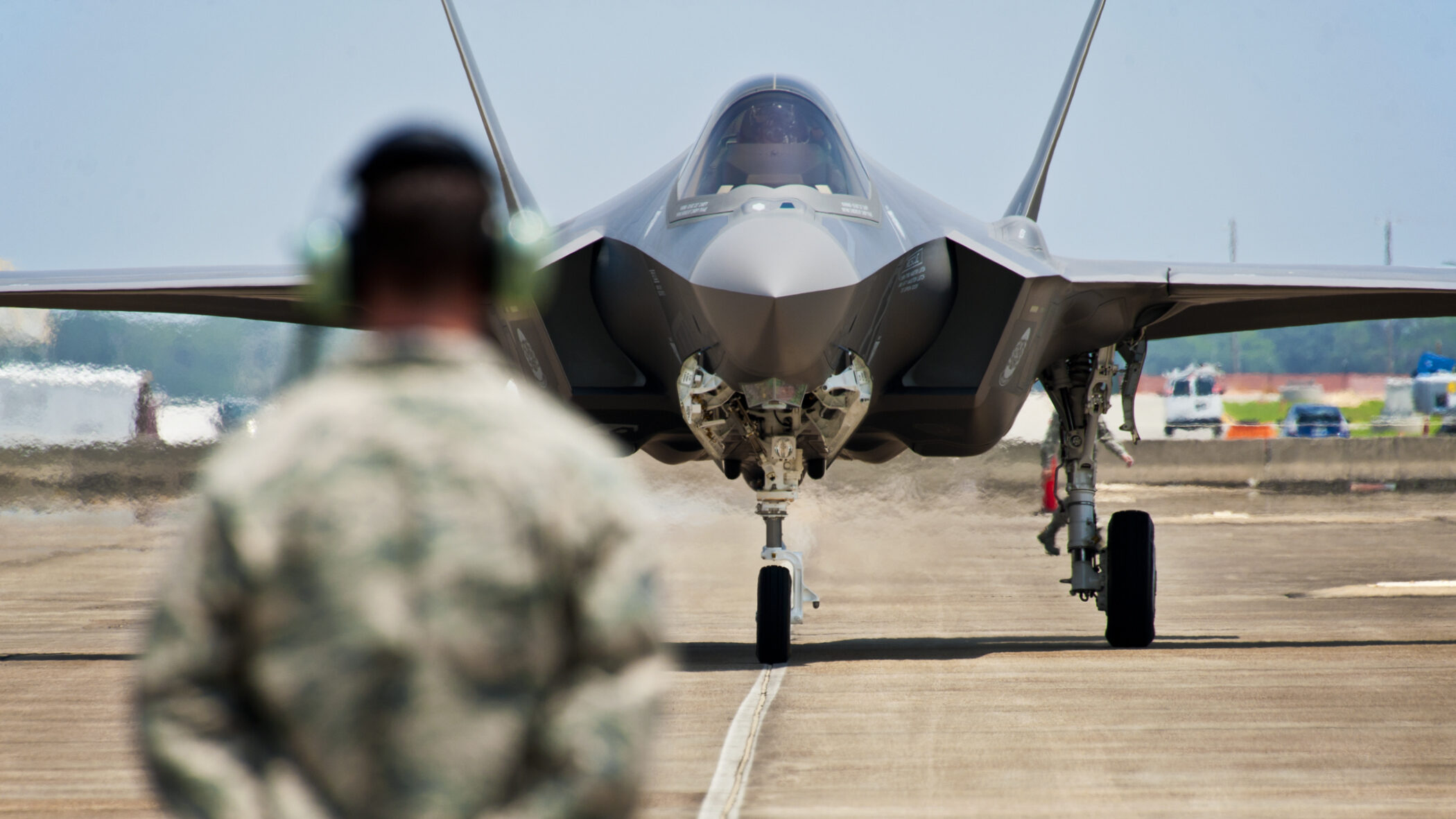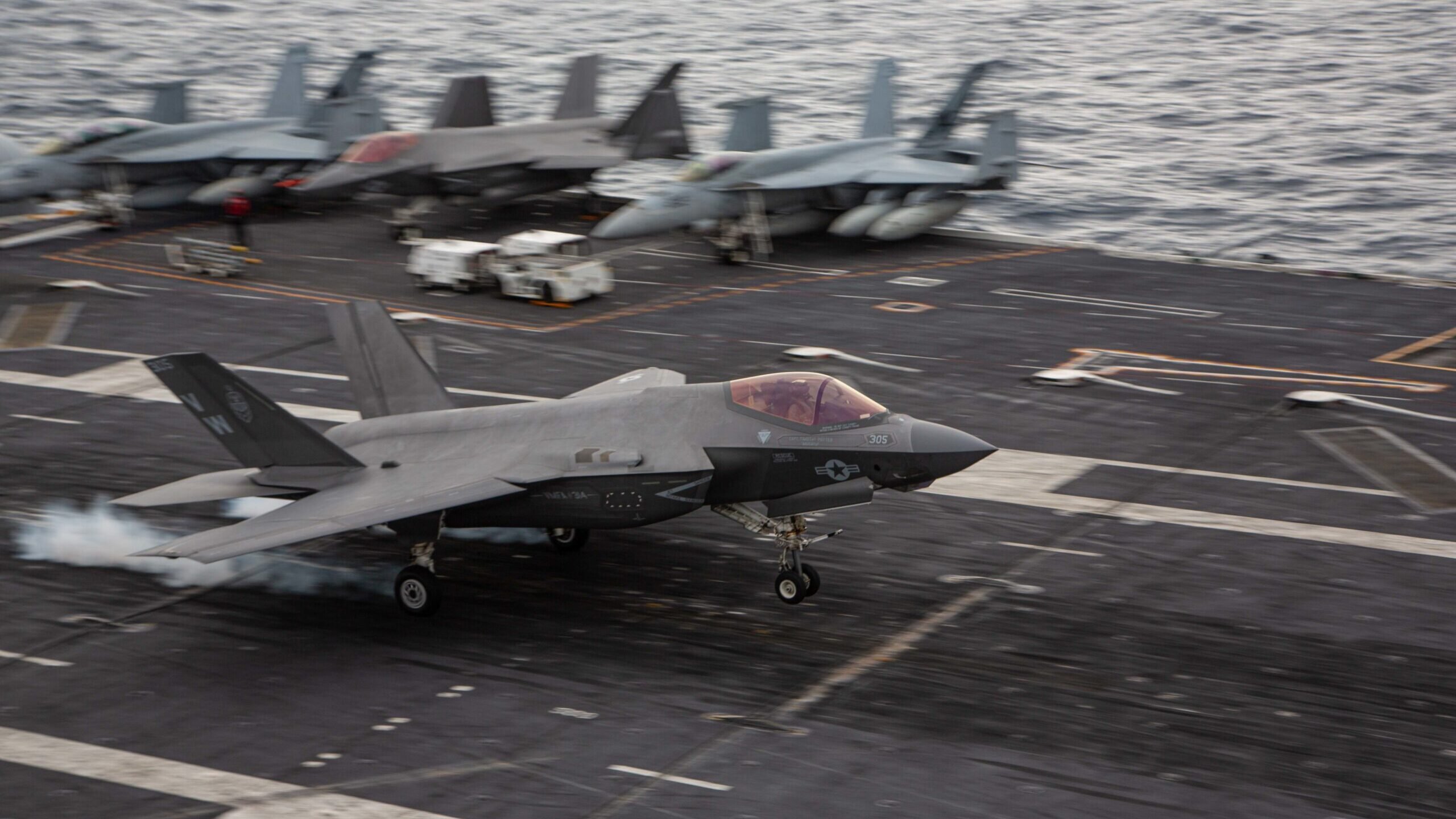
The first operational F-35 is delivered to Eglin Air Force Base, Fla., on July 14, 2011. (Samuel King Jr./US Air Force)
Updated 4/7/21 at 5:02 pm ET: A previous version of this story incorrectly attributed causality between previous GAO observations on engine sustainment challenges with current readiness numbers. Following publication of this article, Pratt & Whitney clarified that an issue associated with the fighter’s engine power module that risked driving down readiness was resolved. The story has been updated to reflect that increased demands placed on the engine pose future maintenance challenges while providing engine degradation estimates supplied by the F-35 Joint Program Office.
WASHINGTON — As the Pentagon and Capitol Hill gear up for a fight over the decision not to pursue a new engine design for the F-35, officials this week stated that increasing demands placed on the legacy F135 engine are poised to wear and tear it at higher than expected rates — resulting in what congressional auditors say is an extra $38 billion in future lifecycle costs.
Adding ammo to those who want to see a new engine design move forward is a statement by the Government Accountability Office that the F-35 program’s endeavor to upgrade the fighter’s engine and thermal management system did not follow established practices identified by GAO for building a business case.
The GAO’s finding of a lack of an analysis of alternatives or comprehensive business case analysis for improving the fighter’s engine and Power and Thermal Management System (PTMS) — what the F-35 program groups together and calls “Air System Modernization” — was one of several issues raised during testimony before the House Armed Services tactical air and land forces subcommittee Wednesday, where lawmakers grilled officials on schedule overruns and cost growth that have long defined the Joint Strike Fighter enterprise.
Just 53.1% of the fighter fleet was found to be mission capable in February 2023, with 29.3 fully mission capable, according to prepared remarks [PDF] delivered by Air Force Lt. Gen. Mike Schmidt, who heads the F-35 program. As of March 1, there were 564 Joint Strike Fighters in the DOD’s inventory, F-35 Joint Program Office spokesman Russ Goemaere told Breaking Defense.
Schmidt said in his statement that he aims to increase availability by at least 10% over the next year and will further launch a “War on Readiness” that gathers the international F-35 community on a biweekly basis to address key sustainment issues. Schmidt is also launching a “War on Cost” to get a handle on the fighter’s rising topline — a phrase the JPO has used at least once before, in 2015, to describe a new initiative, and also one used by engine manufacturer Pratt & Whitney as early as 2009.
As the F-35 program moves toward fielding new capabilities known as Block 4, it will be faced with increased cooling challenges that officials say will require upgrades to both the aircraft’s engine – which the Pentagon intends to pursue by updating the F135 through an Engine Core Upgrade (ECU) – and thermal management system.
The fighter relies on its F135 engine to power the aircraft. Using air pressure extracted from the engine, known as bleed air, the PTMS then cools the aircraft’s subsystems. But since the discovery by Lockheed Martin in 2008 that the PTMS needed more air pressure from the engine than originally expected — and a subsequent decision in 2013 by program officials that turned down an engine redesign to accommodate the extra bleed air need — the powerplant has been forced to run hotter, reducing its lifespan as a result, according to prepared remarks [PDF] delivered by Jon Ludwigson, the Government Accountability Office’s director for contracting and national security acquisitions.
Asked about the impact of the bleed air issue, Goemaere said in a statement that “the engine is running hotter than originally designed in order to provide the required bleed air pressure demands of the aircraft’s Power Thermal Management System (PTMS). This has resulted in a 17% reduction in engine life leading to a $31 billion increase to the projected sustainment cost over the projected life of the F135 program due to scheduled overhauls being required earlier, and more often, than planned. Capabilities currently in development (Block 4) for the F-35,” Goemaere continued, “are expected to decrease engine life by an additional 3% due to the greater demand for bleed air from the engine.”
Ludwigson’s testimony further stated GAO’s preliminary inquiry into the air system modernization plan determined that the F-35 program office never formulated an independent cost estimate or approved acquisition strategy when compiling its analysis on how best to modernize the engine and PTMS. A full report on the air system modernization effort by GAO is expected this spring.
For his part, Schmidt said in response to questions from Rep. Donald Norcross, D-NJ, that the ECU would be fielded between 2030-2032, though he emphasized that more details like testing infrastructure were needed until he could commit to a firm date. Breaking Defense previously reported that the JPO expects that the ECU will be fielded by FY30 with the hope that all customers of the aircraft will pitch in to fund its development.
Schmidt also said that though the program previously faced challenges with a backlog of power modules – the engine’s core – a production ramp up at Tinker Air Force Base’s Heavy Maintenance Center has cleared a pending queue of jets in need of modules, meaning that it is no longer a “top driver” of readiness concerns.
Jen Latka, Pratt’s vice president for F135 programs, further noted to Breaking Defense that since July 2022, the fighter’s engine “has achieved greater than 94% mission capability.” Latka also stated that “previous power module availability challenges were not due to the higher temperatures resulting from increased bleed air requirements.” Instead, Latka explained, a coating on the engine’s turbine blades eroded faster than expected stemming from operations in “hot, sandy, salty environments.” That issue combined with a lack of depot capacity created a backlog, Latka said, which the expanded depot work was able to clear. (Latka also said a new coating was developed in 2020 to address the erosion issue.)
Rep. Rob Wittman, R-Va., who chairs the subcommittee, did not take a position on the plan to update the F135 rather than design a new engine, but made clear he wanted more information from officials as lawmakers move to consider the proposal.
“You know, our job is not to take a position. The [F-35 Joint Program Office] has made that decision. Our job as a subcommittee is to fully understand all aspects of this,” he said, later adding that his committee’s task was to “fully gather every significant piece of information” as congressional debate on the engine decision is poised to unfold.

An F-35C, assigned to Marine Wing Fighter Attack Squadron (VMFA) 314, launches from the flight deck of the aircraft carrier USS Abraham Lincoln (CVN 72). (US Marine Corps/1stLt. Charles Allen)
Fielding Block 4
The program’s air system modernization plan will be critical as officials look to field the Block 4 suite of software capabilities with even more upgrades expected beyond, which will require greater power and cooling. In keeping with the F-35s overall cost and schedule growth, Block 4 has experienced much of the same: an original estimate of $10.6 billion has since ballooned to $16.5 billion, and an extra three years have been added to complete the fielding of Block 4 capabilities through calendar year 2029, according to Ludwigson’s remarks.
Schedule and cost increases for Block 4 are tied as well to difficulties with its underlying enabling hardware known as Technology Refresh 3 (TR-3) that provides new processing capabilities and other attributes. Though the first TR-3 test flight was achieved in January, the program is running a year behind fielding the upgrade, which is now scheduled for April 2024.
Schmidt said during testimony that the April 2024 date reflects the JPO’s current schedule risk assessment, though Lockheed estimates that it could occur a few months earlier in December 2023, leaving a “window” between the two dates. Once TR-3 is integrated and Block 4 capabilities are fleshed out, the F-35 program will reach full operational capability status, which Wittman noted will be nearly three decades since its launch in 2001.
“That is by any measure unacceptable, and the program has to do better,” Wittman said.
Moving Into FRP
After spending years trapped in low-rate initial production the F-35 program is eyeing entrance into the full-rate production (FRP) stage by finishing out work on the fighter’s troubled Joint Simulation Environment (JSE), the last step needed to complete the initial operational test and evaluation phase.
The program made progress in recent months correcting deficiencies with the JSE, GAO found, though six “must-fix” issues remain. After those problems are solved the Pentagon’s Director of Operational Test and Evaluation must verify and validate the JSE, after which the program can proceed with 64 virtual simulations known as runs-for-score. Those runs are scheduled to begin in August 2023, Schmidt said, who added his “line in the sand” to commence FRP is December 2023.
Retrofit Details
Schmidt’s testimony additionally revealed key details about a hardware retrofit recently ordered by the JPO to mitigate a harmonic resonance, or vibration, issue with the F135. According to the general, investigators found during an inquiry into the crash of an F-35B in December that harmonic resonance can cause a fuel tube to fracture, prompting officials to implement a mitigation strategy as they work to establish a root cause for the vibration problem. Defense News reported Tuesday that the vibration issue has been known to the program since an engine failed during pre-delivery testing in 2020, which has since prompted “additional pre-acceptance procedures.”
As work to identify the root cause of the resonance problem continues continues, the retrofit — consisting of “the installation of an orifice” — in the meantime will not prevent the fracturing of the fuel tube but instead “reduces the impact to loss of engine control” if vibration causes it to break, Schmidt stated.
The fleetwide retrofit is ongoing, which Schmidt estimated would enable all backlogged deliveries stemming from a pause in new engine and aircraft acceptances to be complete by May 2023.
According to Ludwigson’s written testimony, engine and aircraft deliveries consistently ran behind schedule in 2022. “Nearly all” F135 powerplant deliveries were delayed last year, which program officials told GAO were caused by “quality issues that required resolution before engines could be accepted by the government.”
In turn, fully half of aircraft deliveries were delayed in 2022, GAO found, the highest level of late deliveries in the past six years. By contrast, 16% of aircraft deliveries in 2021 were behind schedule.






















